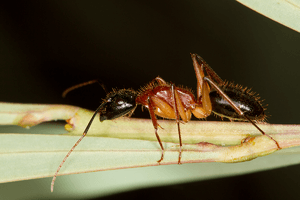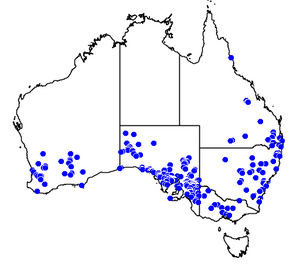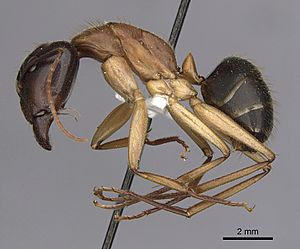Black-headed sugar ant facts for kids
Quick facts for kids Black-headed sugar ant |
|
|---|---|
 |
|
| A black-headed sugar ant worker from Strangways, Victoria | |
| Scientific classification | |
| Genus: |
Camponotus
|
| Species: |
nigriceps
|
| Subspecies | |
|
|
 |
|
| Where C. nigriceps has been seen in Australia (as of April 2015) | |
| Synonyms | |
|
|
The black-headed sugar ant (Camponotus nigriceps) is a type of ant that lives only in Australia. You might also hear it called the brown sugar ant. These ants are found in most parts of Australia. They belong to a large group of ants called Camponotus ants, which are found all over the world.
A British scientist named Frederick Smith first described and named this ant in 1858. Black-headed sugar ants are easy to spot because they have a black head, a reddish-brown middle body (called the mesosoma), and a black lower body (called the gaster). The color of their gaster can sometimes change.
These ants come in different sizes, which is called being polymorphic. Worker ants and soldier ants are usually between 6 and 12 millimeters long. Male ants are about 12 millimeters long. The queens are the biggest ants in the colony, measuring around 16 millimeters.
Black-headed sugar ants like to live in dry places, like open fields or dry woodlands. They build their nests in the soil, in large mounds, or under stones. During summer, new queens and males fly to find mates, which is called a nuptial flight. A single colony can have thousands of ants. These ants are sometimes considered a household pest because they might come into homes looking for food. They love sweet things and also eat insects. They even look after certain butterfly larvae. Many birds and fish like to eat these ants.
Contents
What Are Black-Headed Sugar Ants Like?
Black-headed sugar ants are quite large. They are a polymorphic species, meaning there are two types of workers: minor workers and major workers (also called soldiers).
How Big Are They?
- Worker and soldier ants are usually 10 to 12 millimeters long.
- Male ants are about 12 millimeters long.
- Queens are the largest, measuring around 16 millimeters.
- A smaller type of this ant, Camponotus nigriceps lividipes, has workers and soldiers that are 6 to 10 millimeters long.
What Do They Look Like?
The lower body (gaster) and middle body (mesosoma) of workers can be different colors. The gaster might be black, brown, or yellowish-brown. The mesosoma is usually reddish-brown or yellow. Most workers are brown with lighter spots on their head and mesosoma. Their mouthparts are even darker. Their legs can be black or brown.
These ants have many hairs on their gaster, mesonotum, pronotum, and propodeum. These hairs are about 0.35 millimeters long. They also have golden, upright bristles (called setae) under their head and on their mesosoma. The bristles on their lower legs are shorter than those on their body. Worker ants have bulging eyes, while soldier ants have flatter eyes.
It can be tricky to tell black-headed sugar ants apart from banded sugar ants because they look similar. However, banded sugar ants are darker and have a band around their gaster, which black-headed sugar ants do not have. Scientists often look at the minor worker ants to tell similar species apart.
Where Do Black-Headed Sugar Ants Live?
You can find black-headed sugar ants in most Australian states.
- They live in the north and south-east of Queensland.
- They are common throughout the Australian Capital Territory.
- They are widespread in New South Wales and Victoria, but not in the north-west of New South Wales or the south-east of Victoria.
- In South Australia, they are often seen in the south-eastern parts and less in the north-west.
- They are found in Western Australia, but not in the northern parts of that state or in the Northern Territory.
Their Homes
Black-headed sugar ants mostly live in dry areas, like dry woodlands or open fields. They also like mallee areas, eucalyptus woodlands, and Casuarina cristata woodlands. They can be found at heights between 241 and 319 meters above sea level.
Their nests are often in laterite soil in upland areas, surrounded by tall eucalyptus trees or under groups of trees. You might also find their nests in large mounds or under stones. Sometimes, they even live in cedar wood or in large mounds built by other ants, like the meat ant (Iridomyrmex purpureus).
How Do Black-Headed Sugar Ants Behave?
Black-headed sugar ants are nocturnal, meaning they look for food at night. They are sometimes called a household pest because they might come into people's homes at night to find food. During the day, these ants are not active and seem to "sleep" until it gets dark.
What Do They Eat?
These ants mainly eat sweet liquids and sugar water. They also eat insects and various foods they find in human homes.
Moving Around and Helping Others
When a colony moves to a new nest or when workers need to show others where food is, they use different ways to communicate:
- One worker might carry another worker.
- They might do "tandem running," where one ant follows closely behind another.
- They can lay down a special scent trail (a pheromone trail) to guide others.
Friends with Butterflies
Black-headed sugar ants also look after the larvae (caterpillars) of certain butterflies, like Ogyris idmo and Ogyris genoveva. The butterfly larvae live in underground areas built by the ants. At night, the larvae come out with the ants and eat mistletoe leaves.
Other Nest Mates
These ants are okay with other insects living in their nests. For example, beetles like Ctenisophus morosus and Cryptodus paradoxus have been found in their nests. A wingless cricket called Myrmecophilus australis also lives inside their colonies. Other insects like froghoppers can also be found in their nests.
Who Eats Them?
Many birds and other animals eat black-headed sugar ants. Birds such as the black-faced woodswallow, rufous treecreeper, noisy miner, jacky winter, and southern scrub robin eat these ants. Scientists know this because they have found ant body parts in the birds' stomachs. The rainbow trout fish also preys on black-headed sugar ants.
Colony Life and Lifespan
New queens and males likely start their mating flights (nuptial flights) in summer. A young queen was found in a new nest chamber in January, suggesting this. In the early days of a new colony, there are more soldier ants. Older colonies might have mostly minor workers. A typical colony can have between five and seven thousand ants.
Queens of this species can live for a very long time! Queens found in the wild have lived for up to 21 years. One queen in captivity lived for 23 years, making her the second oldest ant queen ever recorded. The larvae of these ants can also grow quite large, reaching lengths of up to 16.4 millimeters.


